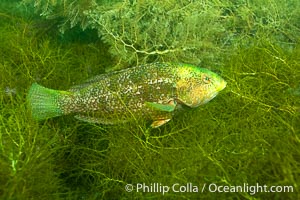
Brownspotted Wrasse, Notolabrus parilus, Kangaroo Island, South Australia.
Species: Brownspotted Wrasse, Notolabrus parilus
Location: Kangaroo Island, South Australia
Image ID: 39247
Species: Brownspotted Wrasse, Notolabrus parilus
Location: Kangaroo Island, South Australia
Image ID: 39247
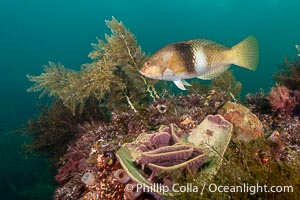
Bluethroat Wrasse, Notolabrus tetricus, Adult Female, Kangaroo Island, South Australia.
Species: Bluethroat Wrasse, Notolabrus tetricus
Location: Kangaroo Island, South Australia
Image ID: 39259
Species: Bluethroat Wrasse, Notolabrus tetricus
Location: Kangaroo Island, South Australia
Image ID: 39259
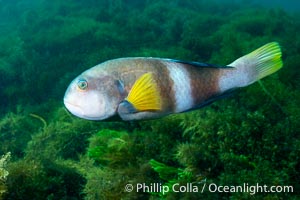
Bluethroat Wrasse, Notolabrus tetricus, Adult Male, Kangaroo Island, South Australia.
Species: Bluethroat Wrasse, Notolabrus tetricus
Location: Kangaroo Island, South Australia
Image ID: 39273
Species: Bluethroat Wrasse, Notolabrus tetricus
Location: Kangaroo Island, South Australia
Image ID: 39273
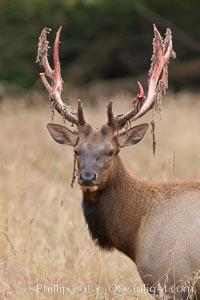
Roosevelt elk, adult bull male with large antlers. This bull elk has recently shed the velvet that covers its antlers. While an antler is growing, it is covered with highly vascular skin called velvet, which supplies oxygen and nutrients to the growing bone; once the antler has achieved its full size, the velvet is lost and the antler's bone dies. This dead bone structure is the mature antler, which is itself shed after each mating season. Roosevelt elk grow to 10' and 1300 lb, eating grasses, sedges and various berries, inhabiting the coastal rainforests of the Pacific Northwest.
Species: Roosevelt elk, Cervus canadensis roosevelti
Location: Redwood National Park, California
Image ID: 25880
Species: Roosevelt elk, Cervus canadensis roosevelti
Location: Redwood National Park, California
Image ID: 25880
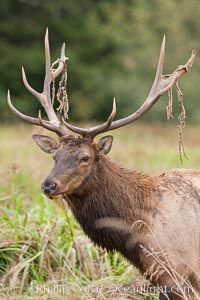
Roosevelt elk, adult bull male with large antlers. This bull elk has recently shed the velvet that covers its antlers. While an antler is growing, it is covered with highly vascular skin called velvet, which supplies oxygen and nutrients to the growing bone; once the antler has achieved its full size, the velvet is lost and the antler's bone dies. This dead bone structure is the mature antler, which is itself shed after each mating season. Roosevelt elk grow to 10' and 1300 lb, eating grasses, sedges and various berries, inhabiting the coastal rainforests of the Pacific Northwest.
Species: Roosevelt elk, Cervus canadensis roosevelti
Location: Redwood National Park, California
Image ID: 25881
Species: Roosevelt elk, Cervus canadensis roosevelti
Location: Redwood National Park, California
Image ID: 25881
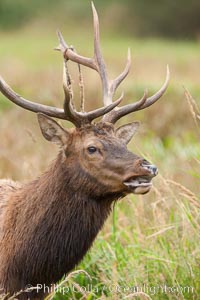
Roosevelt elk, adult bull male with large antlers. This bull elk has recently shed the velvet that covers its antlers. While an antler is growing, it is covered with highly vascular skin called velvet, which supplies oxygen and nutrients to the growing bone; once the antler has achieved its full size, the velvet is lost and the antler's bone dies. This dead bone structure is the mature antler, which is itself shed after each mating season. Roosevelt elk grow to 10' and 1300 lb, eating grasses, sedges and various berries, inhabiting the coastal rainforests of the Pacific Northwest.
Species: Roosevelt elk, Cervus canadensis roosevelti
Location: Redwood National Park, California
Image ID: 25891
Species: Roosevelt elk, Cervus canadensis roosevelti
Location: Redwood National Park, California
Image ID: 25891
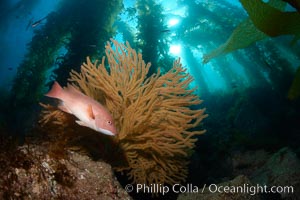
California sheephead and golden gorgonian, giant kelp forest filters sunlight in the background, underwater.
Species: California sheephead wrasse, Muricea californica, Semicossyphus pulcher
Location: Catalina Island, California
Image ID: 23472
Species: California sheephead wrasse, Muricea californica, Semicossyphus pulcher
Location: Catalina Island, California
Image ID: 23472
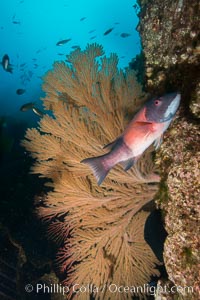
California golden gorgonian and Sheephead wrasse fishes on rocky reef, below kelp forest, underwater. The golden gorgonian is a filter-feeding temperate colonial species that lives on the rocky bottom at depths between 50 to 200 feet deep. Each individual polyp is a distinct animal, together they secrete calcium that forms the structure of the colony. Gorgonians are oriented at right angles to prevailing water currents to capture plankton drifting by.
Species: California sheephead wrasse, Semicossyphus pulcher
Location: San Clemente Island, California
Image ID: 30888
Species: California sheephead wrasse, Semicossyphus pulcher
Location: San Clemente Island, California
Image ID: 30888
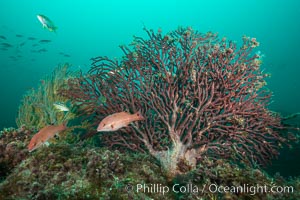
Juvenile sheephead and gorgonian, Catalina.
Species: Sheephead wrasse, Semicossyphus pulcher
Location: Catalina Island, California
Image ID: 30975
Species: Sheephead wrasse, Semicossyphus pulcher
Location: Catalina Island, California
Image ID: 30975
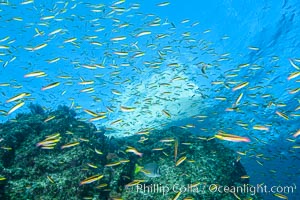
Cortez rainbow wrasse schooling over reef in mating display.
Location: Los Islotes, Baja California, Mexico
Image ID: 32576
Location: Los Islotes, Baja California, Mexico
Image ID: 32576
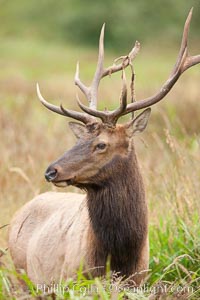
Roosevelt elk, adult bull male with large antlers. This bull elk has recently shed the velvet that covers its antlers. While an antler is growing, it is covered with highly vascular skin called velvet, which supplies oxygen and nutrients to the growing bone; once the antler has achieved its full size, the velvet is lost and the antler's bone dies. This dead bone structure is the mature antler, which is itself shed after each mating season. Roosevelt elk grow to 10' and 1300 lb, eating grasses, sedges and various berries, inhabiting the coastal rainforests of the Pacific Northwest.
Species: Roosevelt elk, Cervus canadensis roosevelti
Location: Redwood National Park, California
Image ID: 25892
Species: Roosevelt elk, Cervus canadensis roosevelti
Location: Redwood National Park, California
Image ID: 25892
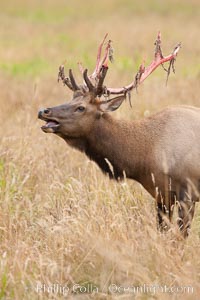
Roosevelt elk, adult bull male with large antlers. This bull elk has recently shed the velvet that covers its antlers. While an antler is growing, it is covered with highly vascular skin called velvet, which supplies oxygen and nutrients to the growing bone; once the antler has achieved its full size, the velvet is lost and the antler's bone dies. This dead bone structure is the mature antler, which is itself shed after each mating season. Roosevelt elk grow to 10' and 1300 lb, eating grasses, sedges and various berries, inhabiting the coastal rainforests of the Pacific Northwest.
Species: Roosevelt elk, Cervus canadensis roosevelti
Location: Redwood National Park, California
Image ID: 25895
Species: Roosevelt elk, Cervus canadensis roosevelti
Location: Redwood National Park, California
Image ID: 25895
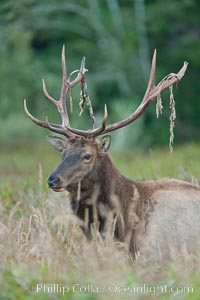
Roosevelt elk, adult bull male with large antlers. This bull elk has recently shed the velvet that covers its antlers. While an antler is growing, it is covered with highly vascular skin called velvet, which supplies oxygen and nutrients to the growing bone; once the antler has achieved its full size, the velvet is lost and the antler's bone dies. This dead bone structure is the mature antler, which is itself shed after each mating season. Roosevelt elk grow to 10' and 1300 lb, eating grasses, sedges and various berries, inhabiting the coastal rainforests of the Pacific Northwest.
Species: Roosevelt elk, Cervus canadensis roosevelti
Location: Redwood National Park, California
Image ID: 25900
Species: Roosevelt elk, Cervus canadensis roosevelti
Location: Redwood National Park, California
Image ID: 25900
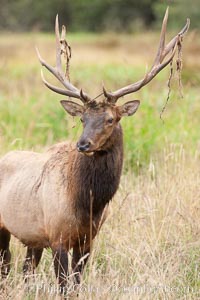
Roosevelt elk, adult bull male with large antlers. This bull elk has recently shed the velvet that covers its antlers. While an antler is growing, it is covered with highly vascular skin called velvet, which supplies oxygen and nutrients to the growing bone; once the antler has achieved its full size, the velvet is lost and the antler's bone dies. This dead bone structure is the mature antler, which is itself shed after each mating season. Roosevelt elk grow to 10' and 1300 lb, eating grasses, sedges and various berries, inhabiting the coastal rainforests of the Pacific Northwest.
Species: Roosevelt elk, Cervus canadensis roosevelti
Location: Redwood National Park, California
Image ID: 25906
Species: Roosevelt elk, Cervus canadensis roosevelti
Location: Redwood National Park, California
Image ID: 25906
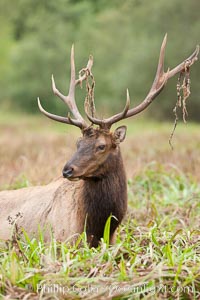
Roosevelt elk, adult bull male with large antlers. This bull elk has recently shed the velvet that covers its antlers. While an antler is growing, it is covered with highly vascular skin called velvet, which supplies oxygen and nutrients to the growing bone; once the antler has achieved its full size, the velvet is lost and the antler's bone dies. This dead bone structure is the mature antler, which is itself shed after each mating season. Roosevelt elk grow to 10' and 1300 lb, eating grasses, sedges and various berries, inhabiting the coastal rainforests of the Pacific Northwest.
Species: Roosevelt elk, Cervus canadensis roosevelti
Location: Redwood National Park, California
Image ID: 25910
Species: Roosevelt elk, Cervus canadensis roosevelti
Location: Redwood National Park, California
Image ID: 25910
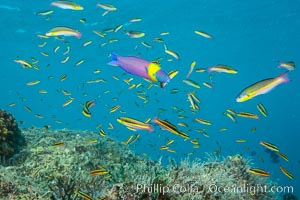
Cortez rainbow wrasse schooling over reef in mating display.
Location: Baja California, Mexico
Image ID: 32477
Location: Baja California, Mexico
Image ID: 32477
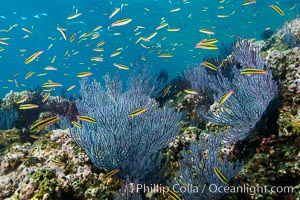
Cortez rainbow wrasse schooling over reef in mating display.
Location: La Reina, Baja California, Mexico
Image ID: 32486
Location: La Reina, Baja California, Mexico
Image ID: 32486
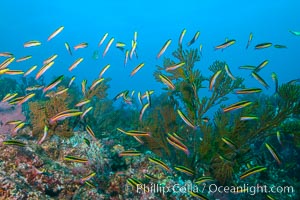
Cortez rainbow wrasse schooling over reef in mating display.
Location: Baja California, Mexico
Image ID: 32568
Location: Baja California, Mexico
Image ID: 32568
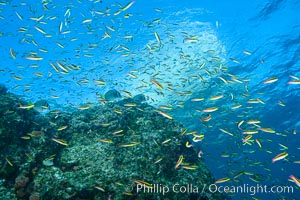
Cortez rainbow wrasse schooling over reef in mating display.
Location: Los Islotes, Baja California, Mexico
Image ID: 32577
Location: Los Islotes, Baja California, Mexico
Image ID: 32577
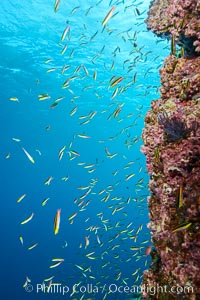
Cortez rainbow wrasse schooling over reef in mating display.
Location: Los Islotes, Baja California, Mexico
Image ID: 32578
Location: Los Islotes, Baja California, Mexico
Image ID: 32578
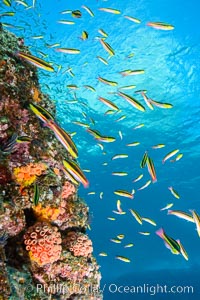
Cortez rainbow wrasse schooling over reef in mating display.
Location: Los Islotes, Baja California, Mexico
Image ID: 32579
Location: Los Islotes, Baja California, Mexico
Image ID: 32579
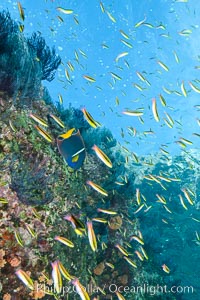
Cortez rainbow wrasse schooling over reef in mating display.
Location: Los Islotes, Baja California, Mexico
Image ID: 32595
Location: Los Islotes, Baja California, Mexico
Image ID: 32595
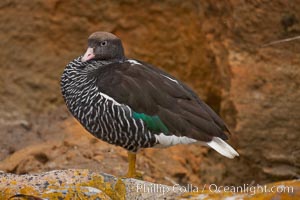
Kelp goose, female with multicolored plumage very different from the pure white of male kelp geese. The kelp goose is noted for eating only seaweed, primarily of the genus ulva. It inhabits rocky coastline habitats where it forages for kelp.
Species: Chloephaga hybrida, Chloephaga hybrida malvinarum
Location: New Island, Falkland Islands, United Kingdom
Image ID: 23758
Species: Chloephaga hybrida, Chloephaga hybrida malvinarum
Location: New Island, Falkland Islands, United Kingdom
Image ID: 23758
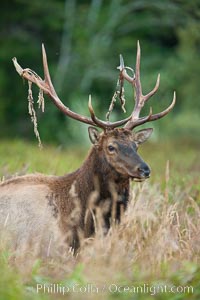
Roosevelt elk, adult bull male with large antlers. This bull elk has recently shed the velvet that covers its antlers. While an antler is growing, it is covered with highly vascular skin called velvet, which supplies oxygen and nutrients to the growing bone; once the antler has achieved its full size, the velvet is lost and the antler's bone dies. This dead bone structure is the mature antler, which is itself shed after each mating season. Roosevelt elk grow to 10' and 1300 lb, eating grasses, sedges and various berries, inhabiting the coastal rainforests of the Pacific Northwest.
Species: Roosevelt elk, Cervus canadensis roosevelti
Location: Redwood National Park, California
Image ID: 26389
Species: Roosevelt elk, Cervus canadensis roosevelti
Location: Redwood National Park, California
Image ID: 26389
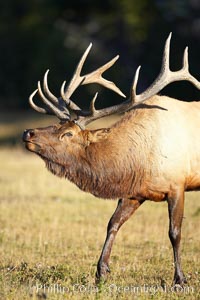
Elk, bull elk, adult male elk with large set of antlers. By September, this bull elk's antlers have reached their full size and the velvet has fallen off. This bull elk has sparred with other bulls for access to herds of females in estrous and ready to mate.
Species: Elk, Cervus canadensis
Location: Yellowstone National Park, Wyoming
Image ID: 19722
Species: Elk, Cervus canadensis
Location: Yellowstone National Park, Wyoming
Image ID: 19722
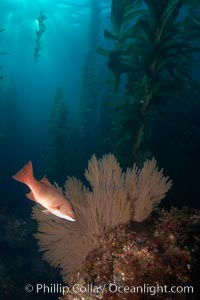
Sheephead and golden gorgonian, underwater in a kelp forest.
Species: California golden gorgonian, Muricea californica, Semicossyphus pulcher
Location: San Clemente Island, California
Image ID: 23528
Species: California golden gorgonian, Muricea californica, Semicossyphus pulcher
Location: San Clemente Island, California
Image ID: 23528
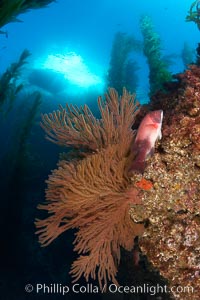
Gorgonians grow on rocky reef, kelp forest and a white boat floating on the surface can be seen in the background, underwater.
Species: California golden gorgonian, Muricea californica, Semicossyphus pulcher
Location: San Clemente Island, California
Image ID: 23537
Species: California golden gorgonian, Muricea californica, Semicossyphus pulcher
Location: San Clemente Island, California
Image ID: 23537
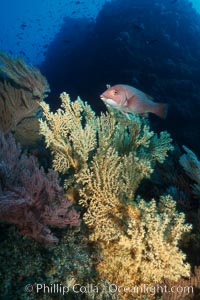
Juvenile sheephead swims above dead/dying brown gorgonian covered with yellow parasitic zoanthid anemones. Eagle Rock.
Species: California sheephead wrasse, Luminescent parazoanthid, Parazoanthus lucificum, Savalia lucifica, Semicossyphus pulcher
Location: Catalina Island, California
Image ID: 07006
Species: California sheephead wrasse, Luminescent parazoanthid, Parazoanthus lucificum, Savalia lucifica, Semicossyphus pulcher
Location: Catalina Island, California
Image ID: 07006
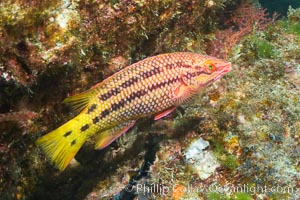
Mexican hogfish, female coloration, Sea of Cortez, Baja California, Mexico.
Species: Mexican hogfish, Bodianus diplotaenia
Location: Sea of Cortez, Baja California, Mexico
Image ID: 27499
Species: Mexican hogfish, Bodianus diplotaenia
Location: Sea of Cortez, Baja California, Mexico
Image ID: 27499
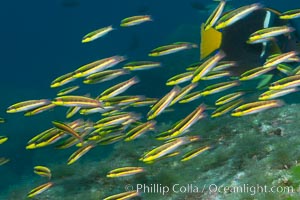
Cortez rainbow wrasse schooling over reef in mating display, Sea of Cortez, Baja California, Mexico.
Species: Rainbow wrasse, Thalassoma lucasanum
Location: Sea of Cortez, Baja California, Mexico
Image ID: 27577
Species: Rainbow wrasse, Thalassoma lucasanum
Location: Sea of Cortez, Baja California, Mexico
Image ID: 27577